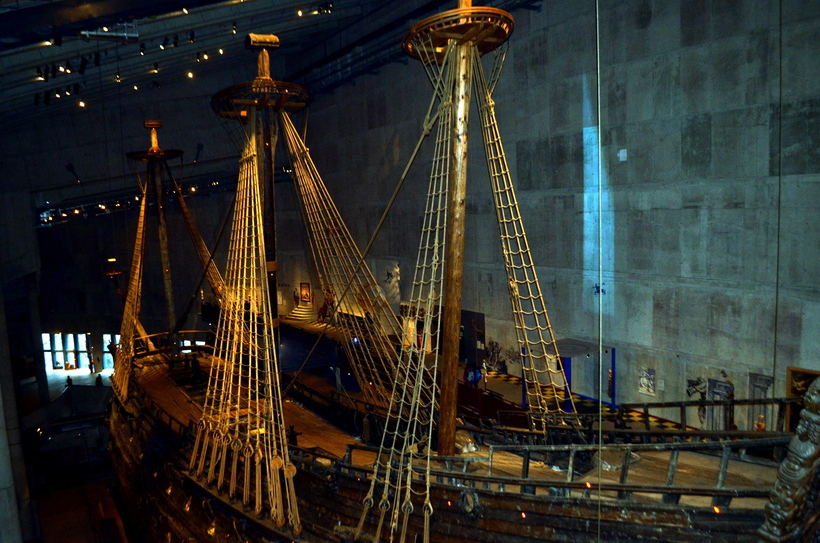The Vasa museum ship is the best maritime attraction in Stockholm.
The Gustav Vasa Museum-Ship (colloquially called the Vasa Museum) is built around one of the most obtuse Swedish ships of the 17th century, famous for sailing less than a mile and then quickly sinking. But it's a flagship. Many attempts were made to raise Vasa's ship. In the end, in 1961 it was raised, restored for 30 years, and in 1990 a museum was built around it on Djurgården. Oddly enough, Gustav Vasa is almost the most visited museum in Stockholm. The exposition also presents an incredible amount of junk raised from the bottom in different parts of the world's oceans.
Needless to say, the Swedes reverently approached the creation of a museum around such a dull fact as a mediocrely designed ship that could not swim and interfered with navigation in one of the harbors of the city for 300 years. The ship Gustav Vasa has been lovingly restored, 3 floors are built around it, allowing it to be walked around and examined from different angles. Here are the skeletons of the crew, wax figures, patriotic paraphernalia, paintings depicting the king himself and several ancient cannons.
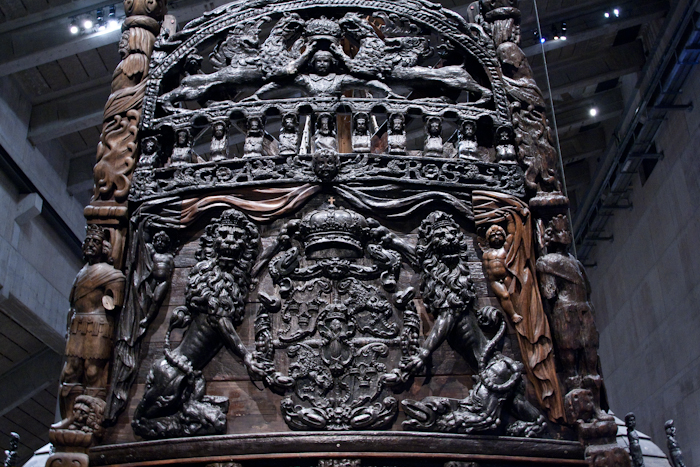
As an added value to the visit, reconstructions of the cramped spaces of medieval ships, many models, a film about the heroic campaign of Gustav Vasa on 9 cables and - the funniest thing - the "save Vasa" attraction are offered. This is a small computer game in which you can try to change the project in such a way that this trough floats away, well, at least 5 miles from the coast (where it would probably be much more difficult to lift it). Unfortunately, after throwing out 2/3 of the cannons, which makes the ship Gustav Vasa conditionally seaworthy, the king sentences you to quartering for creating an incapable flagship. From which we can conclude that Vasa was doomed from the very beginning.
For lovers of maritime history, the museum is of interest. After all, this is the only well-preserved ship of the early 17th century in the world. Diving equipment, the dramatic story of the rise of ships, and regularly held displays about the scrap metal of the deep, which is still waiting for its restorer, can attract the interest of the male part of the population. But otherwise, this is a museum of one exhibit, which is still more of a curiosity than it has a glorious history.
Address Museum "Ship Gustav Vasa": Galärvarvsvägen 14.Working hours: on weekdays from 10 to 17, on weekends from 10 to 20. In summer (from June 1 to August 31) from 8.30 to 18.
www.vasamuseet.se
The Vasa ship, which today is one of the most visited museums in Stockholm, has a unique destiny. It is hard to imagine a ship with a more deplorable and at the same time unusual fate: the sunken ship of the 17th century is still alive.
Through the pages of the history of the unfortunate ship
It was once a Swedish warship, proudly named after Sweden's ruling Vaza dynasty. A great future was predicted for him, as he was the largest and most expensive warship of the entire Swedish fleet. Vasa was planned as a flagship, but was wrecked in the first raid.
January 1625 - the order of the Swedish king Gustav II Adolf to build a new warship designed by the Dutch shipbuilder Henrik Hubertsson; the king himself took an active part in the construction of the ship; for the construction of the giant, more than 16 hectares of the best oak forest were cut down;
1627 Death of Hübertsson, who was replaced by the shipbuilder of the Stockholm shipyard Blasienholmen Hein Jacobsson.
August 1628 - Vasa's ship was launched in Stockholm harbor, but as a result of design errors during its construction, it capsized and sank without even going a mile; failed to save half of the crew - more than 50 people sank along with the ship;
1961 - the ship was raised thanks to the efforts of engineer Anders Fransen, the largest Swedish specialist in naval history; Vasa was carefully conserved and then restored.
In August 1990, on the island of Djurgården around legendary ship a museum was opened, which today is inferior in attendance to all the other sights of Stockholm, of which there are many in this city.
Vasa Ship Museum
The museum building was built individually for the exposition of the ship. Here you can:
- examine Vasa from all sides from different heights;
- visit the cinema hall where a film about the history of the ship is shown;
- book a guided tour;
- see the wax figures of the crew members who died along with the ship, whose appearance was reproduced from the found remains;
- buy a sea souvenir in a small shop;
- have a bite to eat in a themed restaurant on the territory of the museum.
All the sights of Sweden allow tourists to touch the mysterious and legendary past, which is only worth the Unibakken Museum. And the Vasa ship in Stockholm is no exception, because this ancient, unique, original and luxurious ship remained the only surviving sailing ship in the world from the beginning of the 17th century.
Today I will talk about one Swedish museum, the Vasa Museum (Swedish: Vasa Museet). To be honest, when I arrived in Stockholm, I had no plans for this place. The name of the museum is generally heard by tourists. However, many dismiss the thought of visiting when they hear two keywords: “museum-ship”. “Shipbuilding is interesting only to men,” say many of the fair sex. “And really, what could be remarkable there for a person who is not at all versed in shipbuilding? Whether it's the classic art or natural science museums that are familiar to the eye, ”I thought. But what was my surprise when I heard the story of a woman who willingly shared her vivid impressions of a trip to the Vasa Museum with two other young ladies. Without thinking twice, I went there - I decided not to follow the prevailing stereotypes, which I advise you too.
"Vasa" made the most amazing impression on me. This is one of the most memorable museums I've been to! I bring to your attention short review and some important details.
How to get there
This amazing museum is located on one of the islands in the center of Stockholm Djurgården ( Djurgarden). To get to it, in my opinion, the best way is from the Old City (Gamla-Stan). Why? Old city- this is the place where most of the travelers come in the very first place. It's like Palace Square in St. Petersburg or Red Square in Moscow.
Personally, I went to the Vasa Museum from the Royal Palace. In order not to get lost in Stockholm, you can choose it as a guide and a strong point: it is visible from afar. I walked for about 30 minutes, as it is written on the map below. Of course, you can go faster. However, the incredible beauty of Art Nouveau architectural buildings, embankments, harbors, and simply magnificent views that open up to the eye will not leave you indifferent ... so it’s unlikely that you will be able to stop or not slow down :).
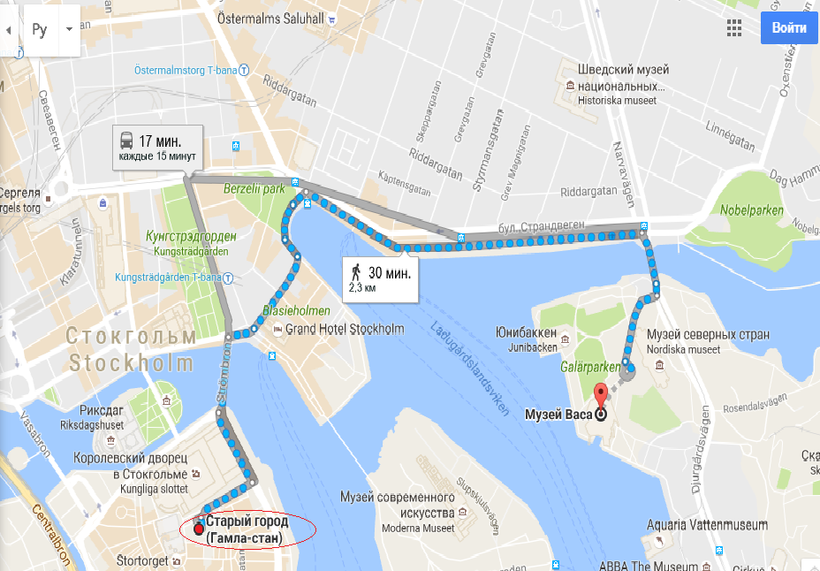 However, for those who prefer to use public transport, there is an alternative - the bus. To get to the Vasa Museum, you need to cross the bridge and go to the Stockholm Karl XII:s torg stop. Bus number 76 departs from there every 15–17 minutes (depending on the time of day). Read about how to purchase tickets and passes for public transport. You will need to drive four stops and get off at Stockholm Djurgårdsbron. Then, keeping to the right side, go straight (3-4 minutes). Oops, and you are there.
However, for those who prefer to use public transport, there is an alternative - the bus. To get to the Vasa Museum, you need to cross the bridge and go to the Stockholm Karl XII:s torg stop. Bus number 76 departs from there every 15–17 minutes (depending on the time of day). Read about how to purchase tickets and passes for public transport. You will need to drive four stops and get off at Stockholm Djurgårdsbron. Then, keeping to the right side, go straight (3-4 minutes). Oops, and you are there.
If you decide to get to the Vasa Museum from other parts of the city, then nearby museums can serve as landmarks: the Museum of the Northern Peoples (Nordiska museet), located in a beautiful neo-Renaissance building, as well as the famous Skansen open-air museum ( Skansen). You can see them in the photo below.
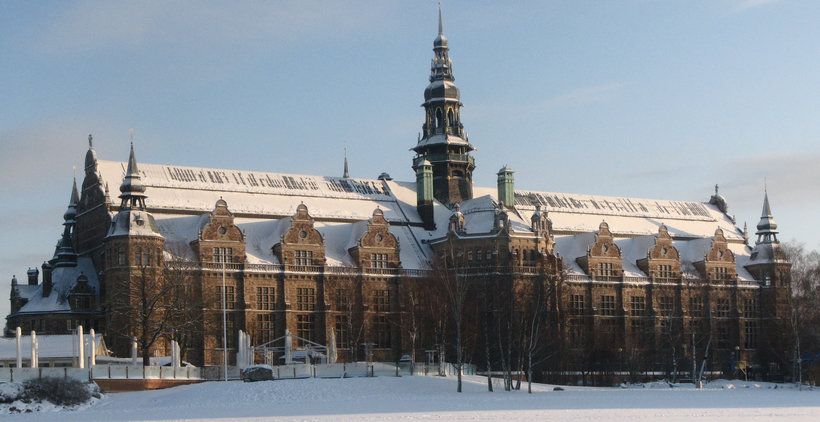

In general, the island of Djurgården, on which the museums listed above are located, can rightly be considered a museum island. There is also a museum dedicated to the ABBA group and the Aquaria Vattenmuseum.
So. If you are not coming from the Old Town, the nearest metro station to the museum is Karlaplan (Karl's Square). But "next" is putting it mildly. From the metro you will need to take bus number 67, drive 3 stops and get off at Stockholm Nordiska museet/Vasa. And then walk for 5 minutes.
Well, now let's talk directly about our museum.
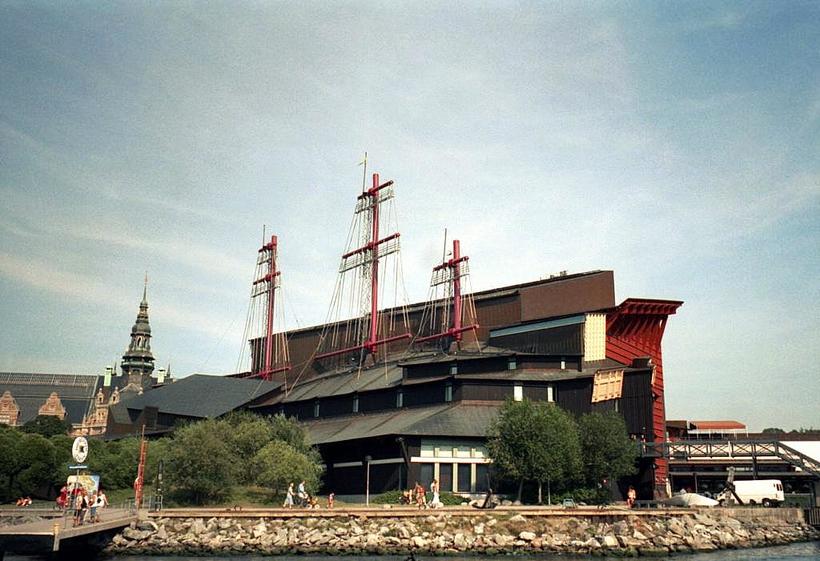
The exterior of the building is vaguely reminiscent of a ship. Going inside, the first thing, of course, you will need to buy an entrance ticket.
Entry fee
adults
13 EUR (130 SEK, SEK)
students
10 EUR (100 SEK)*
Children (under 18)
is free
* student discount is available only upon presentation of a student card; by the way, it is not necessary to take ISEC with you (but it will not be superfluous), our Russian one is also accepted (at least that was the case during my stay in the spring of 2016).
Working hours
- from January 2 to May 31 and from September 1 to December 30 - 10:00-17:00, on Wednesdays - 10:00-20:00 (Vasa restaurant 10:00-16:00);
- from June 1 to August 31 - 8:30-18:00 (Vasa restaurant - 9:30-17:30);
- December 31 - 10:00-15:00 (Vasa Restaurant - 11:30-14:00).
- January 1, from December 23 to 25 - closed!!!
Museum exposition
The museum occupies a space of six floors, each of which tells about the history of the creation and construction of Vasa, the life of sailors. The exposition presents individual preserved elements of decor, models, models of the ship and its cabins, personal belongings of sailors. Look for the most extraordinary exhibits on the second floor - these are the faces of sailors restored from the remains of the bones.
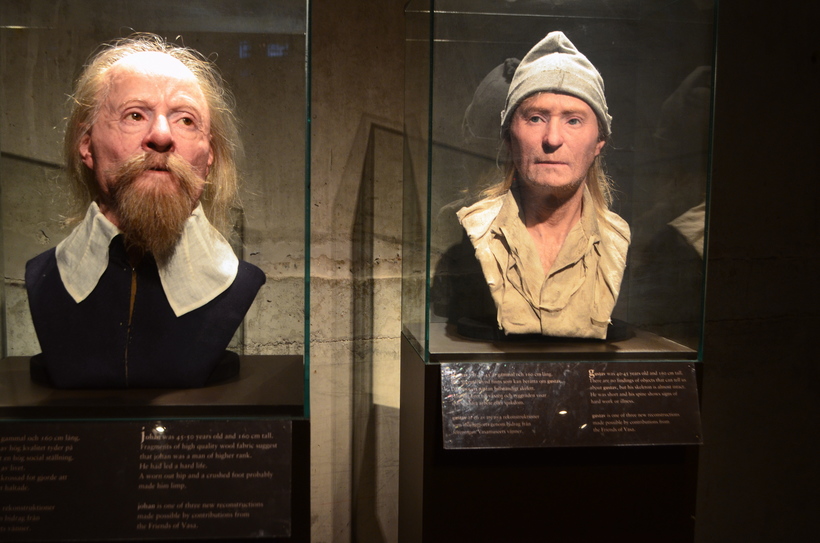
Of course, in the very center of the museum there is OH - the ship "Vasa", which can be approached from different sides, look at it from different points. The size of the ship is quite impressive.

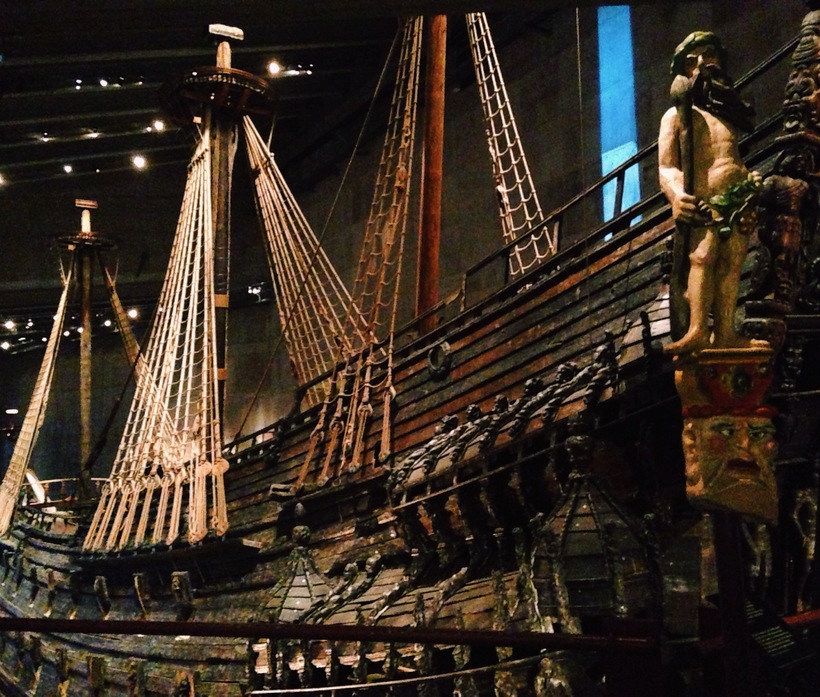
By the way, why is it called that?
Story
The ship was named after the Vasa dynasty that ruled at the time of its construction. Then, back in 1628, great hopes were placed on this ship. Vasa was to be the largest ship in the history of the Swedish Navy. Surely you paid attention to the phrase "should have". This is no coincidence.
In the same year, at the first exit to the harbor, the ship, which had departed literally a few meters, went under water. The tragedy was unheard of. On board, along with the sailors, were their wives, and the ship itself was escorted by the townspeople. The reason for the crash was the wrong, even, to be more precise, erroneous design of the ship. A national tragedy was inevitable.

And what, in fact, was then? Attempts to rise to the surface - a repeated number of times. But it turned out to be done, imagine, only in the 20th century, in 1961. From that moment, serious restoration work began: the best restorers worked for many years. The mothballed and restored ship was placed in a building specially designated for the museum, and in 1990 the Vasa Museum was opened.
By the way, remember the interesting architecture of the museum building? Now I'll tell you. After the ship was pulled ashore, it was brought into a 19th-century ship dock filled with water. Then the water was pumped out of the dock, and work began on the construction of the museum pavilion. The building is made of concrete and has three stylized masts on the roof.
This is where I stop my story. I will not reveal all the cards, because otherwise the incentive to get to "Vas" will disappear :). Don't worry, you'll find out everything on the spot. In the museum you can take an audio guide, a tour, or independently study the history of the ship with the help of explications and brochures (available in Russian).
The ship "Vasa" is a Swedish sailing warship with a displacement of 1210 tons. Its width was 11.7 meters, and the length was 69 meters, the height was 52.5 meters. The crew consisted of 145 sailors and 300 soldiers, who served 64 guns. Work on the construction of the ship began in the spring of 1626 at the Stockholm shipyard. Finished in autumn 1627. In 1628 a huge battleship was launched and equipped with guns and ammunition. During his first voyage on August 10, 1628, he sank 120 meters from the coast at a depth of 32 meters, passing through the water in a total of no more than 1.5 km.
Brief background
At the beginning of the 17th century, the Swedes did not have large ships armed with heavy cannons. In principle, small ships were also quite suitable for the Baltic Sea, but the Swedish king Gustav Adolf (1594-1632) was extremely ambitious. He decided to create the backbone of the fleet, consisting of large battleships. According to his idea, there should have been 5.
The first in this series was Vasa. But, as they say, the first pancake is lumpy. As for the other 4 warships, they successfully served in the Swedish fleet until the 60s of the 17th century. They were called royal ships, and they differed from the sunken ship in that they were 1.5 meters wider.
Chronology of the death of "Vas"
The ship got its name in honor of the Swedish dynasty Vasa, who ruled the country at that time. After the completion of construction work, it was completed with canvas for a long time. In Sweden, canvas was not sewn, so I had to order it in France, the Netherlands and Germany. The sails were made from hemp and partly from flax. The body itself was assembled from oak boards.
In January 1628, the king visited the ship, which was to become the pride of the Swedish fleet. After that, the floating bulk was towed from the shipyard and placed near the royal palace in Stockholm. It was equipped with ballast, as well as weapons and ammunition. Only by the beginning of August the ship was fully prepared for sailing. The first exit to the open sea was scheduled for August 10.
It was Sunday, and they decided to make it a holiday. Not only crew members, but also members of their families - wives and children - boarded. An orchestra was placed at the stern, which was supposed to play solemn melodies. The weather was favorable for sailing: the day was clear and the wind was light. On her first voyage, the ship was supposed to reach the naval base located south of Stockholm.
A huge crowd of people had gathered on the pier. The townspeople came to stare at the huge battleship, which was larger than all warships in the world. The giant handsome was towed to the south side of the harbor, where he spread the sails. The ship's cannons saluted the public on the pier with a thunderous volley, which responded with an enthusiastic roar of thousands of throats. After that, "Vasa" proudly swam into the open sea.
But even in the open area of the bay, something incomprehensible began. A strong gust of wind filled the sails, and the ship heeled heavily. However, the gust weakened, and the ship leveled off. It safely reached the exit from the bay, but then an even stronger gust of wind again tilted the huge ship. He lay down on the port side and, to the horror of onlookers, began to sink.
Boats from ships moored in the bay headed to the crash site. But when they approached, the ship was already almost completely submerged. Rescuers began to pick up people floundering in the dark water. Most of the women, children, sailors were saved. Between 30 and 50 people died. The tragedy occurred in front of thousands of people crowded on the shore. Among the townspeople were foreign ambassadors and spies of warring states. All of them witnessed the terrible disgrace of the Swedish dynasty and King Gustavus Adolf himself.

Reasons for the death of "Vas"
The king himself was in Prussia at that time, so he learned about the tragedy only after 2 weeks. He immediately sent a dispatch to Stockholm, in which he demanded a thorough investigation and punishment of those responsible.
In accordance with this, all surviving members of the crew were interrogated. The investigators were interested in: was the crew sober at the time of the tragedy, was the ballast properly laid, were the guns securely fixed? Each of the interrogated swore that he had clearly fulfilled his duties. In the end, the sailors' answers were found to be satisfactory and no evidence was found.
After that, they began to interrogate those who built the ship. The situation was aggravated by the fact that Henrik Hubertsson, who was responsible for the project and construction, died back in 1627. After that, the project was headed by the shipbuilder Hein Jacobsson. It was from his testimony that the real reasons for the death of the Vasa ship became clear.
It turns out that the ship's center of gravity was too high, and the width of the craft was not large enough. All that Jacobsson could do in this situation, having received the authority of the head of construction, was to increase the width of the ship's hull by 42 cm. It did not work anymore, since the hull was already almost assembled. As for Henrik Hubertsson, he was guided by the calculations that the king personally approved.
Errors in the calculations caused the instability of the huge sailboat. The ballast could not fix them either. It was too small, and the narrow design did not give more to put. In a word, it turned out that the king was personally to blame for the tragedy, since he trusted unscrupulous designers and approved deliberately incorrect calculations. But the investigation did not dare to bring the reigning person to justice. As a result of all this, the case was put on the brakes and no one was punished.
The further fate of the sunken ship
The ship lay at a depth of 32 meters, and its masts stuck out above the water. Therefore, in the 17th century, attempts were made to raise the ship. Of particular interest were powerful guns, of which there were 64. The drowned ship was hooked with anchors and they tried to drag it to the shore, which was only 120 meters away. But nothing happened.
Therefore, they abandoned the idea of raising the entire ship and decided to confine themselves to only bronze cannons, which were of the greatest value. But each gun weighed a ton and was tightly attached to the carriage. In addition, the cannon had to be pulled out through the cannon hole and managed to be raised to the surface.
In 1658, a special team of divers was created under the leadership of the Swede Albrecht von Treileben. Using a diving bell, these people in 1664-1665 raised 54 cannons from a sunken sailboat. But that was the end of the rescue work.
Years dragged on, and the ship was safely forgotten. But the most remarkable thing is that the coordinates of its location have also been forgotten. No one could tell where the huge handsome man, stuffed with ballast and wet gunpowder, rested on the seabed.
Only in the early 50s of the 20th century archaeologist Anders Franzen became interested in the sunken floating craft. He was convinced that over the past 300-odd years the ship had been well preserved, since there were no shipworms in the Baltic. A persistent search began for a giant sailboat resting on the seabed. It took several years until Vasa was found in August 1956. The Swedish fleet was connected to the rise of the ship, and in April 1961 the well-preserved hull emerged from the water.

Vasa Museum
The ship received the status of a historical monument. At the end of 1961, it was placed in the building and began to be shown to tourists. But the room was narrow, and the maximum distance to the sailboat was only 5 meters. Therefore, it was impossible to see it in its entirety.
In 1988, they decided to open a new, larger museum. And on August 16, 1990, the Vasa Museum was opened on the Stockholm island of Djurgården, which functions to this day. The new building has good visibility from all sides and at different levels. Tourists flock to admire the sailboat, which is over 300 years old. There is nothing else like it in the world. And the flow of people since 1961 is estimated at 29 million people.
The ship "Vasa" could not serve its people in the distant XVII century. But on the other hand, in the 21st century, he conscientiously serves Sweden, bringing tangible income to its treasury. This is a clear example of the connection of times and respect for ancient traditions. It was they who became the reason for the second birth of the ship, which seemed to have sunk into eternity forever.
› Have you seen the world's only surviving ship of the 17th century? Museum of one ship.On one of the central islands of Stockholm, where the Swedish kings once hunted, there is an unusual angular building. Two red structures in the form of ship masts rise above its dark roof. This is a museum of one exhibit - the Vasa ship, the only ship of the 17th century in the world, whose wooden structures are 95% preserved. It sank after swimming for only half an hour.

“Between four and five o'clock, the huge new ship Vasa capsized and sank” ... The chronicler wrote just a few words about the catastrophe that befell Sweden and the Swedish fleet on a warm August day in 1628.
In Europe at that time the Thirty Years' War was going on - Catholics fought with Protestants. King Gustav II Adolf of Sweden, on whose orders the Vasa ship was built, fought on the side of the German Protestants. He fought very successfully, for which he was nicknamed the "Northern Lion"
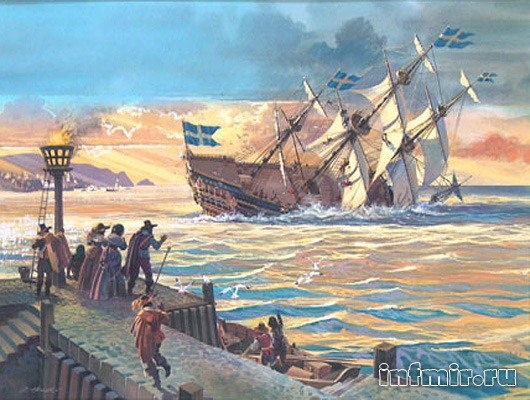
More than 300 years have passed, and they decided to raise the ship. There was no exact information where he sank (archival documents indicated several different places). 38-year-old engineer Anders Fransen, an enthusiast and expert on ancient wrecks, designed a special sampler and began searching in 1953. And then on August 25, 1956, a piece of blackened wood stuck in the sampler. The divers descended, felt the side of the ship with two rows of gun hatches - it became clear that this was the Vasa ship. We decided to try to pick it up. But how? There were many offers. For example, to freeze the ship into a block of ice, and when it emerges, tow it to shallow water. The ice will melt, the ship will remain! Or fill it with ping-pong balls, which will lift the ship.

But the most realistic idea prevailed: flush six channels under the hull, pass cables through them and raise Vasa on pontoons. Divers who performed this most difficult work in complete darkness at a depth of 30 meters, under the hull of a three-hundred-year-old ship, risked their lives daily. The tunnels were so narrow that people could hardly squeeze through them, air hoses could get tangled (and sometimes tangled!) in beams, boards and other debris at the bottom. And besides, at any moment a multi-ton hull with ballast-stones in the bottom could collapse. But, fortunately, everything worked out, and in August 1959 the ship was ready to rise.
First, the hull was torn off the bottom and towed to a depth of 15 meters. Then, for two years, divers plugged thousands of holes from the missing bolts, strengthened the stern and closed all the cannon hatches. And, finally, on April 24, 1961, the long-awaited moment came - the contours of the legendary ship slowly and solemnly appeared from under the water.
There was no such old and at the same time so well-preserved ship in the world. (Prior to this, the palm belonged to the English ship "Victoria" of Admiral Nelson, but he is 137 years younger than "Vasa"). On the day the ship was raised, almost all of Sweden froze. People took time off from work, schoolchildren skipped classes - everyone clung to the TV screens or listened intently to the radio. Journalists from all over the world described this grandiose event.
The honor of being the first to step on the ship was given to its "discoverer", engineer Fransen.
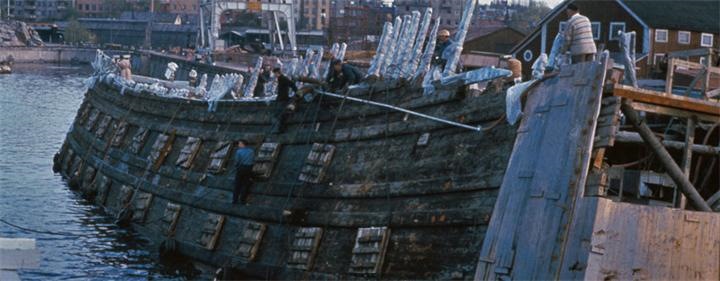
Why is Vasa so well preserved? In the cold Baltic Sea, in its slightly salty water, there is no carpenter shell, which rather quickly eats a tree in the warm southern seas. And then all the bolts rusted (there were several thousand), all the carved decorations fell off, and about 14 thousand different parts were raised from the bottom of the sea. Often the working tool of the restorers was an ordinary metal rod: they applied the part to the board and passed the rod through the holes. If the holes matched, then a place for the part was found. And only those parts and details that were not found were made from lighter wood.
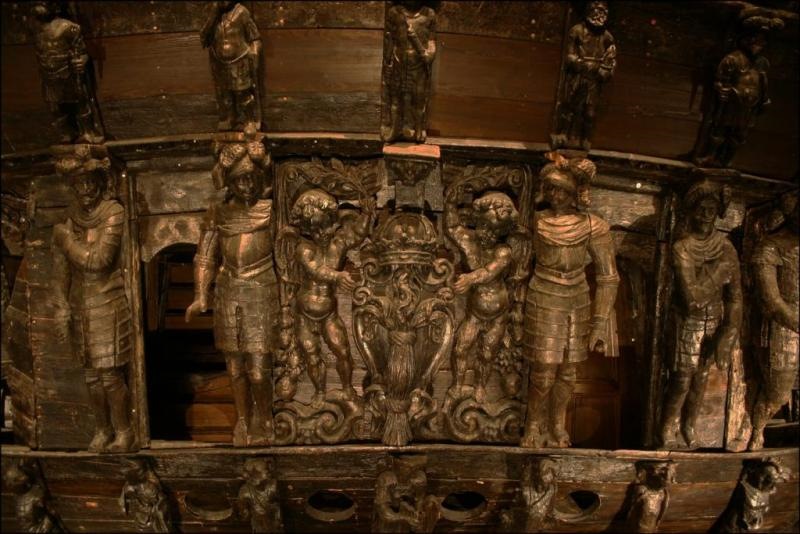
The restorers managed to solve the hardest problem tree conservation. Usually, when the tree is taken out of the water, the liquid evaporates and the wood shrinks, cracks and breaks. There was no experience in the world of conservation of such a large object. Therefore, they decided to build a special covered dock, where the ship was towed on a pontoon base, and for 17 years the hull was irrigated day and night with a composition that replaces water. For every kilogram of wood, there was one and a half liters of water. It was necessary to remove 580 tons of water from the hull! At first, the work was done manually, then a fully automated system was installed with 500 mouthpieces outside and inside the case.
Dock became a temporary exhibition "hall" for the ship "Vasa". One of the first to visit was the King of Sweden, Carl XVI Gustaf, who was fond of archeology and provided great support for the work on raising the vessel. The restorers cleaned the ship's hull and all items from silt and dirt. Leather products were preserved, fabrics and dishes were cleaned and dried.
Visitors to the temporary museum at that time were greeted by a rather dense fog from the sprayed liquid. As a result, a black wet case was barely visible, from which it was constantly dripping. Nevertheless, in the 27 years of the existence of this cramped temporary museum, more than 11 million people have come to see Vasa.

Difficult work lay ahead with the sails. From time to time they were so packed in the hold that they could collapse at the slightest touch. They were carefully transferred to a fiberglass base and impregnated with a preservative composition.
When, finally, they finished the preservation of the ship, found a place for all the figures and details, “Vasa”, as the sailors say, “on his keel” set off on his last voyage, to the place of the “eternal” parking - to the dock located on the territory of the old military shipyard. Moreover, the museum building was erected around the main “exhibit”. Now, from the seven decks of the museum, the ship can be seen perfectly in all details. The showcases contain authentic items of the 17th century: shoes, clothes, dishes, barrels for storing provisions (they were hung from the ceiling to protect against rats), a cauldron in which food was to be cooked for almost 500 people, medical supplies of a barber doctor, a game, reminiscent of modern backgammon, the first smoking pipes. The crew was very poor: the only gold item found on the ship was a ring and a few more coins in the pocket of one of the victims.
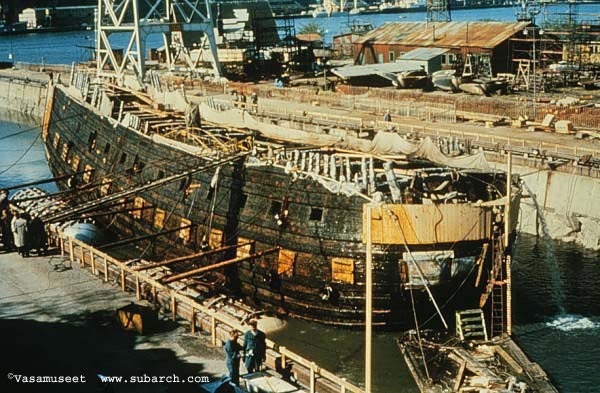
Vasa was one of the largest and most beautiful ships of its time, not only in Sweden, but also in Europe. Its height is 52.5 meters, length - 69 meters, stern height - almost 20 meters. Seven hundred different figures adorned the ship.
The ship was built in the Baroque era - a fun, mischievous time. Here is some puffy-bodied mermaid or nymph sticking out her tongue and licking the tip of her nose. Here stands a soldier and thoughtfully scratches his beard. But a snake crawls out of the eye socket of a figure symbolizing death... Moreover, all the figures are brightly painted, some are gilded. And against the backdrop of a light wood body, they created a sense of festivity.
The ship is equipped with last word contemporary naval technology. On two gun decks, 64 bronze cannons are installed, of which 48 pieces are 24-pounders (each weighing more than a ton). Yes, six more mortars, and a large amount of gunpowder and a variety of cores for sea battle.
Today it seems strange to us: why was it necessary to decorate a warship in such a way, to spend so much money and effort on such “non-functional” “excesses” for naval combat. But such was the spirit of the times. The rich decor of the ship was considered an essential part of its "armament", a demonstration of the power of the state.

The plots are taken from ancient Greek mythology, the Bible and Roman history. These are images of Hercules and fabulous griffins, mermaids and dolphins, biblical warriors and lions (there are more than sixty symbols of royal power), Roman soldiers and emperors, singing and trumpeting angels. In addition, it “tells” about the legendary Swedish kings. Moreover, the most “important” sculptures were covered with real gold: for example, huge lions on the nose 3.5 meters long! And all this splendor, together with snow-white sails, bright flags and scorching cannons, should have made a magical impression ...
Gustav II Adolf named the ship after his famous grandfather, King Gustav Vasa, who ruled in the 16th century. But “Vasa” is not a name, but a nickname of the king, which means “sheaf of hay” in translation. The king gathered together the scattered parts of Sweden, like ears of corn gathered in a sheaf. It was Gustav Vasa who converted Sweden from Catholicism to Protestantism, introduced succession to the throne (kings were elected before him), and, finally, he practically made Stockholm the capital of Sweden. By the way, in those days the names of the ships were not yet written on the sides. At the stern, the emblem of the owner or the person in whose honor or memory the ship was built was usually strengthened, and everyone understood what it was called.


As a legacy from his father, King Charles IX, Gustav II Adolf received a rather large fleet, but pretty battered by battles and bad weather. And in 1615, the State Council notes: “The navy, on which the welfare of the country rests, has been almost forgotten over the past years and therefore needs to be updated.”
In the first years of the reign of the young king, there were no funds to build new ships.
But by 1620, the economic situation in the country had improved significantly, and the king was able to invite Dutch craftsmen, who at that time were considered the most skilled shipbuilders. Everywhere in the shipyards, work began to boil. By 1625, 25 new warships were built, and the king orders the largest and most beautiful ship to be laid down, which should become a thunderstorm on the seas and frighten the enemies of the kingdom.
In the 17th century, they still did not know how to make calculations and drawings for the construction of ships. Everything was based on the experience of shipbuilders and on summary tables, which gave the main dimensions of the ship and its main parts. These tables were handed down from father to son and kept in strict confidence. Usually the ship's master preliminarily built a reduced model of the ship (for some reason this was not done in the case of Vasa).

There were 145 crew members and 300 soldiers on the Vasya. But closed premises existed only for the admiral and officers. The life of soldiers and sailors then passed on open gun decks. There were no beds, mattresses, blankets. Slept in clothes right on the deck. The sailors received 6 meters of fabric per person per year (and its cost was deducted from the salary) and sewed their own clothes. Usually it was a short jacket and knee-length pants.
The entire food supply was preserved on the Vasa ship, thanks to which it became known how sailors ate in the 17th century. The diet included dry bread, salted or dried fish or meat, pea, bean or lentil soup, flour, lard, butter. Since the main methods of preservation in those days were salting and smoking, spicy food caused intense thirst. But they didn’t take water - the water was rotten. They took beer.
The team received hot meals once a day. It was distributed in clay bowls to several people. On the admiral's table stood pewter, faience and glassware, the team managed with wooden plates and spoons, which quickly became saturated with fat and acquired an unpleasant odor. Yes, and the food was often spoiled: the bread was moldy, the butter ran rancid, worms started in meat and fish ...
During the voyage, almost a third of the crew dropped out. But not from battle wounds, but from diseases - the usual companions of sailors of all fleets. But, to the honor of the admiral, a large supply of lemons was found on the Vasya. Apparently, it was already established by experience that they help with scurvy.

Vasa was laid down at the shipyard, located on the island of Blasieholmen (now this island is located in the very center of Stockholm). The work was supervised by the experienced Dutch shipbuilder Henrik Hubertsson, who by this time had already built several ships for Sweden. There were 300 “permanent” workers at the shipyard. Yes, plus a lot of invited “specialists”: ship carpenters, sawyers, blacksmiths, ropemakers, sailmakers, glassblowers, coopers, gunners, wood carvers, figure painting specialists ...
The exact date of the “Vasy” bookmark has not been preserved. But it is known that this happened in the spring of 1626. And in August 1628, he already set off on his tragic voyage. Before sailing, the admiral, according to the rules of that time, tested the ship for stability. 30 sailors ran from one side to the other and back. But after the third dash, the admiral stopped the test - the ship swayed so much that it could roll over right at the pier. The only thing he said was: “If only His Majesty were at home!” (The king was in Europe at that time.) “We will go to sea if God and the wind so desire,” the admiral wrote. And this is not an exaggeration. The ships were unmaneuverable and clumsy, it was almost impossible to change sails in the narrow passages between the islands at the exit from the harbor of Stockholm. Therefore, ships often anchored, waiting for a fair wind. The short way from Stockholm to the open sea (just a few kilometers) could take a month, or even a month and a half. While with a tailwind, it only takes a week!

Since the exit to the open sea of such a huge ship as Vasa could take two or three months, the soldiers had to walk along the coast on foot and board the ship already at the exit. And the team at this time was allowed to take their wives and children with them to the ship, which, of course, no one counted.
The ship stood at the royal palace, where it was loaded with weapons and provisions. On Sunday, August 10, the weather was sunny, warm, with occasional light gusts of wind. On the shore and on the surrounding rocks, the inhabitants of Stockholm crowded. Even foreign ambassadors were present. Still would! Such an event is the departure of a mighty frigate sparkling with all colors and gold. Two formidable gilded lions, arching in a leap at the prow of the ship, cast ferocious glances. No less frightening lion muzzles were on each gun hatch. Wooden warriors stood in a single formation, ready to repel the attack of the enemy. Cannons peeked out of all gun ports (hatchways).
The first 600 meters "Vasa" passed with the help of an anchor. They took the anchor on the boat, threw it, the ship pulled up, pulled the anchor, took it further, threw it again ... Then four out of ten sails were raised (six remained in the hold, they have survived to this day - these are the oldest sails in the world ).
The huge ship moved slowly and majestically. But he swam somehow uncertainly, and when, after the next volley of cannons, the smoke dissipated, in front of the astonished spectators, Vasa sank to the bottom ...
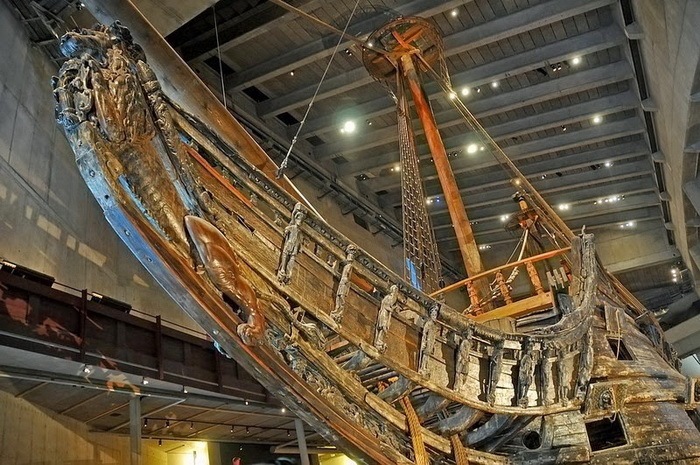
Crew members, women, children tried to escape by swimming, some clung to the tops of the masts, which remained sticking out at the place of the ship's death (it sank at a depth of just over 30 meters, and the height of the masts, we recall, was 52 meters). The people were removed by the ships and boats accompanying the frigate. The death toll is not known exactly, but it is believed to be between 30 and 50 people.
The ship passed about 1300 meters and stayed in independent navigation for no more than half an hour. This is how the State Council described what happened in a letter to the king: “When the ship went into an open bay near Tegelviken, the sails were filled with a stronger wind and soon the ship began to list to the leeward side, but straightened up a little and reached Beckholmen, where it fell on board, water gushed through cannon ports, and he slowly went to the bottom with sails and flags and everything.”
The admiral, who at that time was checking the fastening of the guns, wrote: “While I was rising from the lower deck, the water rose so high that the ladder came off, and only with great difficulty did I get out of there.”
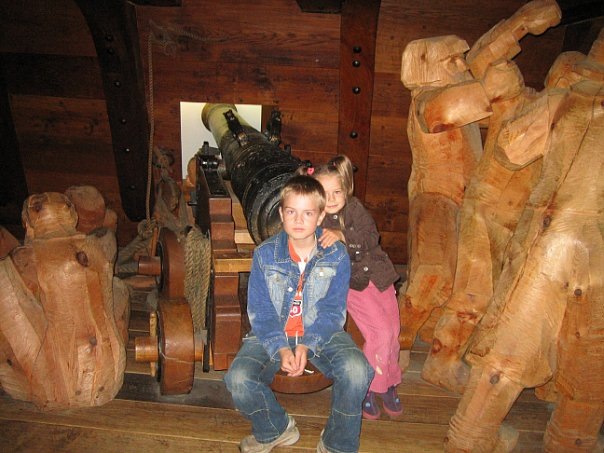
Photo from my archive, these are copies of the interior of the VASA and wooden sculptures of the crew. Visitors are not allowed inside the real ship.
The royal court appointed to determine the perpetrators began to sit in the royal palace the very next day after the disaster. Questions were primarily addressed to a native of Denmark, Captain Sefring Hansson:
The team was drunk?
The captain claims under oath: the ship sailed on Sunday, many were at communion, and “I swear before the Almighty that no one on board was drunk.”
The guns were badly fixed?
You can cut me into a thousand pieces if the cannons were not fixed, Hansson replies. And the admiral confirmed it.
Got a little ballast?
All the ballast was on board, it was impossible to take more - there was no room.
I must say that, to the credit of the Swedish royal court, no one was found guilty.
When the ship was raised to the surface three centuries later, all the cannon carriages were in their places - so the accusation that the cannons were poorly fixed was rightly removed. And it was impossible to take more ballast - there was no place.

And yet, who is to blame? It seems that there were several culprits, more precisely, those who made mistakes that led to the death of the ship.
And above all, King Gustav II Adolf himself. He was too hasty with the construction, and besides, he personally approved the dimensions of the vessel (which was conceived as a single-deck). But the king wanted a ship with maximum number guns, for which it was necessary to add another gun deck during construction. And Vasa was the only ship with two rows of gun ports.
The fault lies with the shipbuilders. The fact is that during the construction Henrik Hubertsson died and another master, Hein Jacobsson, completed it - in accordance with the dimensions that the king approved.
And finally, according to modern theory, the first voyage was to take place with closed gun hatches.
But no one, naturally, dared to say that “His Majesty” was to blame. As shipyard tenant Arent de Groot remarked, “God only knows who is to blame.” But neither God nor the king is beyond the jurisdiction, and the judges did not look for “scapegoats”, and the case was closed.

Immediately after the disaster, they tried to raise the ship, or at least expensive bronze guns, but all attempts ended in failure. But when the diving bell was invented by the end of the 17th century, about 50 cannons were recovered. It was a titanic work! Through the gun hatches in the dark and cold, with the help of various hooks and tools on long handles, heavy guns were removed from the carriages by touch, pulled out through the hatches and raised to the surface. The air supply was enough for a maximum of an hour. (In the twentieth century, a diver in a space suit, equipped with modern equipment, takes a whole day to do such a job!)

Photo from personal archive.
There is a cinema hall in the VASA ship museum in Stockholm, where different languages you can watch a film with elements of a reconstruction of events, here is an episode in Russian:
For those who are interested, I have two more videos on this topic, one of them is a 58-minute film, a complete reconstruction of the events in Swedish about the construction and death of the ship, taking you to the atmosphere of 1628.
Museum address: Sweden, Stockholm city, Galarvarvsvagen street 14.
Thank you all and have a nice day!
1 year Tags: vasa ship, vasa museum

